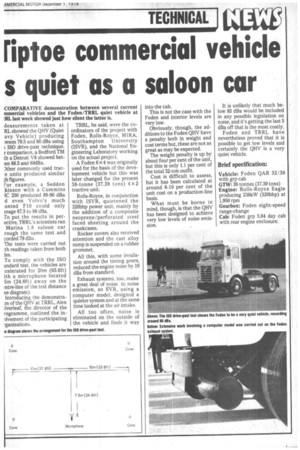riptoe commercial vehicle $ quiet as a saloon car
Page 23

If you've noticed an error in this article please click here to report it so we can fix it.
COMPARATIVE demonstration between several current mmercial vehicles and the Foden/TRRL quiet vehicle at tRL last week showed just how silent the latter is.
Measurements taken at RL showed the QHV (Quiet avy Vehicle) producing ween 79.5 and 80 dBa using .! ISO drive-past technique. r comparison, a Bedford TM th a Detroit V8 showed bet!en 88.5 and 89dBa.
Dther commonly used trace units produced similar ;h figures.
For example, a Seddon .kinson with a Cummins iC 250 produced 89-90 dBa d even Volvo's much unted FIO could only mage 87.5 to 88 dBa.
To put the results in perective, TRRL's scientists ran Marina 1.8 saloon car rough the same test and corded 79 dBa.
The tests were carried out ith readings taken from both ies.
To comply with the ISO andard test, the vehicles are :celerated for 20m (65.6ft) ith a microphone located 5m (24.6ft) away on the !ntre-line of the test distance ee diagram).
Introducing the demonstraan of the QHV at TRRL, Alex ilverleaf, the director of the rogramme, outlined the inDlvement of the participating rganisations. TRRL, he said, were the coordinators of the project with Foden, Rolls-Royce, MIRA, Southampton University (ISVR), and the National Engineering Laboratory working on the actual project.
A Foden 6 x4 was originally used for the basis of the development vehicle but this was later changed for the present 38-tonne (37.39 tons) 4 x 2 tractive unit.
Rolls-Royce, in conjunction with ISVR, quietened the 320bhp power unit, mainly by the addition of a composite neoprene/perforated steel faced sheeting around the crankcases.
Rocker covers also received attention and the cast alloy sump is suspended on a rubber grommet.
All this, with some insulation around the timing gears, reduced the engine noise by 10 dBa from standard.
Exhaust systems, too, make a great deal of noise to noise emission, so SVR, using a computer model, designed a quieter system and at the same time looked at the air intake.
All too often, noise is eliminated on the outside of the vehicle and finds it way into the cab.
This is not the case with the Foden and interior levels are very low. Obviously, though, the additions to the Foden QHV have a penalty both in weight and cost terms but, these are not as great as may be expected. The weight penalty is up by about four per cent of the unit, but this is only 1.1 per cent of the total 32-ton outfit.
Cost is difficult to assess, but it has been calculated at around 8-10 per cent of the unit cost on a production-line basis.
What must be borne in mind, though, is that the QHV has been designed to achieve very low levels of noise, emission. It is unlikely that much below 85 dBa would be included in any possible legislation on noise, and it's getting the last 5 dBa off that is the most costly.
Foden and TRRL have nevertheless proved that it is possible to get low levels and certainly the QHV is a very quiet vehicle.


































































































































